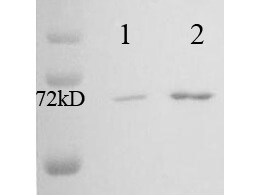Datasheet is currently unavailable. Try again or CONTACT US
Hsp70/Hsc70 (Plant) Antibody
Mouse Monoclonal 5G1-95 IgG1
200-301-F65
100 µg
Liquid (sterile filtered)
WB, ELISA
Plants
Mouse
This product is discontinued
Product Details
Anti-HSP70/HSC70 (Plant) (MOUSE) Monoclonal Antibody - 200-301-F65
HSC54, Hsc70, HSC71, Hsp70 1, Hsp701/Hsp70 2, Hsp70.1, Hsp71, Hsp72, Hsp73, HSPA1, HSPA10, HSPA1A, HSPA1B, LAP1, NIP71, Heat shock 70 kDa protein
Mouse
Monoclonal
IgG1
Target Details
HSP70
Plants
Other
Hsp70/Hsc70 (plant) Antibody was produced in mice by repeated immunizations raised against purified Hsp70 from Phaseolus aureus (mung bean).
Anti-Hsp70/Hsc70 Antibody was purified by Protein G chromatography. A BLAST analysis was used to suggest cross-reactivity with Hsp70 from various plant species based on 100% homology with the immunizing sequence. Recognizes constitutive and inducible plants Hsp70 (Hsc70/Hsp72). Does not cross-react with human, Rat, bacteria (DNAKK) or human Bip. Cross-reactivity with Hsp70 from other sources has not been determined. Heat Shock research.
Application Details
ELISA, WB
Anti-Hsp70/Hsc70 Antibody is tested for WB and ELISA. Expect a band approximately ~70kDa corresponding to the molecular mass Hsp70 on SDS PAGE immunoblots. Specific conditions for reactivity should be optimized by the end user.
Formulation
1mg/ml by UV absorbance at 280 nm
0.02 M Potassium Phosphate, 0.15 M Sodium Chloride, pH 7.2
0.1% (w/v) Sodium Azide
50% (v/v) Glycerol
Shipping & Handling
Dry Ice
Store vial at -20° C prior to opening. Aliquot contents and freeze at -20° C or below for extended storage. Avoid cycles of freezing and thawing. Centrifuge product if not completely clear after standing at room temperature. This product is stable for several weeks at 4° C as an undiluted liquid. Dilute only prior to immediate use.
Expiration date is one (1) year from date of receipt.
Hsp70 genes encode abundant heat-inducible 70-kDa hsps (hsp70s). In most eukaryotes hsp70 genes exist as part of a multigene family. They are found in most cellular compartments of eukaryotes including nuclei, mitochondria, chloroplasts, the endoplasmic reticulum and the cytosol, as well as in bacteria. The genes show a high degree of conservation, having at least 5O% identity. The N-terminal two thirds of hsp70s are more conserved than the C-terminal third. Hsp70 binds ATP with high affinity and possesses a weak ATPase activity which can be stimulated by binding to unfolded proteins and synthetic peptides. When hsc70 (constitutively expressed) present in mammalian cells was truncated, ATP binding activity was found to reside in an N-terminal fragment of 44 kDa which lacked peptide binding capacity. Polypeptide binding ability therefore resided within the C-terminal half. The structure of this ATP binding domain displays multiple features of nucleotide binding proteins. All hsp70s, regardless of location, bind proteins, particularly unfolded ones. The molecular chaperones of the hsp70 family recognize and bind to nascent polypeptide chains as well as partially folded intermediates of proteins preventing their aggregation and misfolding. The binding of ATP triggers a critical conformational change leading to the release of the bound substrate protein. The universal ability of hsp70s to undergo cycles of binding to and release from hydrophobic stretches of partially unfolded proteins determines their role in a great variety of vital intracellular functions such as protein synthesis, protein folding and oligomerization and protein transport.
This product is for research use only and is not intended for therapeutic or diagnostic applications. Please contact a technical service representative for more information. All products of animal origin manufactured by Rockland Immunochemicals are derived from starting materials of North American origin. Collection was performed in United States Department of Agriculture (USDA) inspected facilities and all materials have been inspected and certified to be free of disease and suitable for exportation. All properties listed are typical characteristics and are not specifications. All suggestions and data are offered in good faith but without guarantee as conditions and methods of use of our products are beyond our control. All claims must be made within 30 days following the date of delivery. The prospective user must determine the suitability of our materials before adopting them on a commercial scale. Suggested uses of our products are not recommendations to use our products in violation of any patent or as a license under any patent of Rockland Immunochemicals, Inc. If you require a commercial license to use this material and do not have one, then return this material, unopened to: Rockland Inc., P.O. BOX 5199, Limerick, Pennsylvania, USA.

